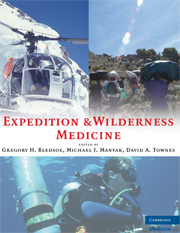Book contents
- Frontmatter
- Contents
- Contributors
- Foreword
- Preface
- Acknowledgments
- PART I EXPEDITION PLANNING
- PART II EXPEDITIONS IN UNIQUE ENVIRONMENTS
- PART III ILLNESS AND INJURIES ON EXPEDITIONS
- 24 General Medical
- 25 The Diarrhea of Travelers
- 26 Malaria: Diagnosis, Prevention, and Treatment for the Traveler
- 27 Wild Animal Attacks and Injuries
- 28 Snake and Arthropod Envenoming
- 29 Hazardous Marine Life
- 30 Expedition Toxicology
- 31 Environmental Injuries
- 32 Penetrating and Explosive Wounds
- 33 Drowning and Submersion Injury
- 34 Evaluation and Acute Resuscitation of the Trauma Patient
- 35 Principles and Practice of Expedition Wound Management
- 36 Expedition Eye Injuries and Disorders
- 37 Dental Medicine on Expedition
- 38 Foot Injuries
- 39 Expedition Orthopedics
- 40 Expedition Self-Rescue and Evacuation
- 41 Aeromedical Evacuations
- APPENDIX The Expedition Medical Kit
- Index
28 - Snake and Arthropod Envenoming
from PART III - ILLNESS AND INJURIES ON EXPEDITIONS
Published online by Cambridge University Press: 05 March 2013
- Frontmatter
- Contents
- Contributors
- Foreword
- Preface
- Acknowledgments
- PART I EXPEDITION PLANNING
- PART II EXPEDITIONS IN UNIQUE ENVIRONMENTS
- PART III ILLNESS AND INJURIES ON EXPEDITIONS
- 24 General Medical
- 25 The Diarrhea of Travelers
- 26 Malaria: Diagnosis, Prevention, and Treatment for the Traveler
- 27 Wild Animal Attacks and Injuries
- 28 Snake and Arthropod Envenoming
- 29 Hazardous Marine Life
- 30 Expedition Toxicology
- 31 Environmental Injuries
- 32 Penetrating and Explosive Wounds
- 33 Drowning and Submersion Injury
- 34 Evaluation and Acute Resuscitation of the Trauma Patient
- 35 Principles and Practice of Expedition Wound Management
- 36 Expedition Eye Injuries and Disorders
- 37 Dental Medicine on Expedition
- 38 Foot Injuries
- 39 Expedition Orthopedics
- 40 Expedition Self-Rescue and Evacuation
- 41 Aeromedical Evacuations
- APPENDIX The Expedition Medical Kit
- Index
Summary
Note: If this chapter is being consulted for a medical emergency please turn immediately to Table 28.4 on page 406.
INTRODUCTION
Few topics in backcountry medicine have proved as controversial as the field management of venomous injuries from wild animals and arthropods. One reason for the controversy is that recommendations for stabilizing and treating venomous or “envenoming” injuries in the resource-constrained settings are often in conflict, require capabilities beyond those available in the wilderness, or endorse interventions later found to be injurious to the victim. For expedition medical personnel and others providing care in austere environs, adapting front-country medical protocols for the management of venomous injuries to the backcountry can prove a daunting challenge. The need for evidence-based recommendations for the prevention and treatment of envenoming injuries has increased in recent years, along with the number of international sojourners and military personnel who are injured by venomous exotic fauna. As international travel and ease of access to previously denied regions continues to improve, increased numbers of untrained travelers will continue to come in contact with a large number of medically significant venomous animals. A compiled list of medically significant venomous terrestrial animals is provided in Table 28.1. The problem has been complicated further by the emergence of new high-risk adventure activities, which increases the risk of encounters with several types of venomous animals. For example, four expatriate envenoming cases seen by one western air medevac service over a 3-year period resulted from “extreme adventure” tour operators who intentionally created close encounters between venomous snakes and paying customers.
- Type
- Chapter
- Information
- Expedition and Wilderness Medicine , pp. 396 - 416Publisher: Cambridge University PressPrint publication year: 2008



